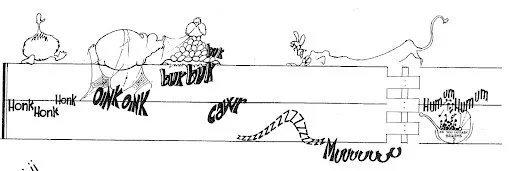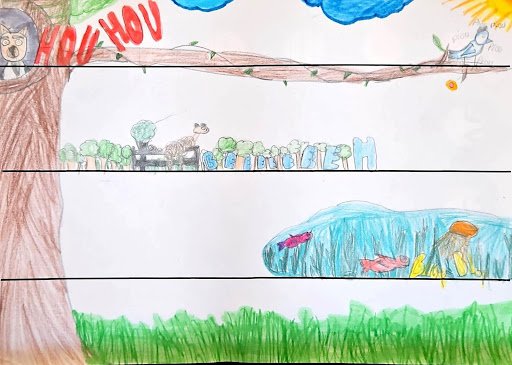Introducing middle-school students to music reading: learning music with a young audience
Maxime Proix is a certified teacher of music education and choral singing. Before working for the French Ministry of Education, he wrote a research paper on Disney Studios music and its use at Disneyland Paris. He is also a saxophonist and holds a diploma in orchestral conducting. Drawing on all this experience, Maxime Proix brings his know-how to bear here to explain the process of introducing young middle-school students to music.
"J'ai solfège" or "j'ai musique, on s'en fiche, c'est une sous-matière": these two phrases are heard and repeated generation after generation by those who study music, in conservatories, music schools or colleges.
The "musical training" stage at conservatories and music schools is generally compulsory, to learn music theory more effectively and produce music. Most beginners take a one-hour course. Time increases with experience.
What do we mean by "musical education"?
Music education in junior high schools (from its full name, music education and choral singing) is an hour that is set aside in the timetable. The learning of music theory is partly cut back in order to produce music in a more direct way, to build a musical culture, to construct a critical (and objective) opinion, and to develop writing skills and oral presentations. This work forms part of the "Performing or creating musical projects" and "Exploring, imagining, creating and producing" competencies.
Learning music is perceived in a negative light in the above-mentioned cases. In the case of conservatory teaching, practice is often carried out in the context of an extra-curricular activity, whereas musical training is an activity close to the lecture aspect. And the way lessons are structured, even if they have evolved over time, has an off-putting, un-fun aspect to it: we're constantly harping on the reading of notes or rythm in order to make score reading more fluid, just as we learn to read syllables, words and then sentences. In my case, I experienced this as a slow and boring moment, which lost interest after a few minutes.
Rejuvenate your music learning
In junior high school, music education is seen by students as a secondary part of the timetable, less tiring than the 3 or 4 hours of weekly French, math or history. This image is reinforced by subsequent generations, who believe that "music class" is a class where you listen to classical music and play the flute. In recent meetings with parents, I've been told that "my daughter loves music, she sings at home, she loves [name the latest fashionable singer]". Music education still has a lot of clichés to break.
It's all about removing preconceived notions of length and uninterestingness through more playful, interactive activities.
Oral learning
Learning through orality is a process used before musical writing (developed from the 10th century onwards). It involves a dialogue between a soloist or a group of soloists and a choir that responds to the first group. In working-class circles, this oral transmission was a major factor in learning music and musical works: it enabled people to learn a song quickly enough, and to convey a message effectively.
Oral learning is a very important point. It helps develop listening skills and an understanding of the four parameters of sound (timbre, pitch, duration, intensity). The work can be personal, involving exploration of one's own body, or in a group, involving a game of question-answer or imitation between the singer and listeners. The "answer" group will consciously or unconsciously reflect on the sound parameters to be set up in order to imitate the "soloist" group.
By mobilizing your instrument or voice and your listening skills, you explore the parameters that you can simply associate with a term. It is the repetition of this process that leads to an understanding of the parameters.
Mobilizing the body
Mobilizing the body is a way of visualizing the different parameters that make up a sound and therefore a score. Associating a gesture with a musical act has a stronger impact on the young musician's mind.
For example, to create a slow musical phrase, you can make a slow, stretched gesture with your arm, or walk with slow steps that you associate with the pulse. This principle also helps develop speed stability and awareness of musical tempo.
To evoke the register (high, medium, low), simply adjust the height of your arms or body, and the intensity with small or large gestures.
Timbre can be worked on by playing with props that imitate real instruments (a whistle for woodwinds, a bottle neck for brass instruments, or strings for string instruments).
Then, as with oral learning, all you need to do is associate this gesture, which is much more visual than a purely musical imitation process, with a term.
Breaking the fear of partition
Music is a language, and learning it is akin to learning a language. The notes associated with rhythms can be compared to syllables, a group of notes to a word and, to speak of a succession of rhythms, we use the term phrase, with its breaths and cadences.
Giving body to the score: the Stripsody system
In the same way as for the mobilization of the body and the visual aspect of music, we can find a different way of reading and thus interpreting a musical score. Twentieth-century composer Cathy Berberian uses this method with Stripsody The artist has created a score in the form of a comic strip, combining the principle of a musical score with the mobilization of the body explained above.
A staff has 3 lines (treble, midrange and bass), and the size and gestures of the drawing evolve according to the pitch and intensity desired by the composer.
Combining the mobilization of the body with a non-musical graphical score makes it possible to imagine the different sounds and sound parameters, and then retranscribe them in pictorial form. Pupils can then write coherently with their gestures.
Turn your music-reading table into a comic book!
In the following case, for a 6th grader (aged between 11 and 12): the assignment was to create a score in comic strip form on a theme (in this case, animals), setting up a decor and detailing precisely the sound parameters to be achieved. We understand that the desired order is owl - sheep - fish - owl, the bold red showing a fairly loud hoot, the length of the "beeh" a long sheep call and the discretion of the "bloup bloup" a discreet fish. Before creating the score, students had to find their own sounds based on the theme, interpret them, work on them and analyze their interpretation.
Conclusion: give priority to learning through play, without neglecting the theoretical reading of notes!
This work makes it easier to bring back students who have difficulty understanding, non-musicians or students who drop out of the class. The fun aspect removes any apprehension or demotivation when faced with a score, which can be seen as a complex document made for specialists.
As with all teaching, learning through play, by dramatizing the work and concepts covered, will make the basics of music easier to grasp and understand.
However, these apprenticeships for a young amateur audience cannot replace all the theoretical learning that goes on in lessons, and therefore the reading of notes, rhythms and all other reading and listening exercises.
Would you like to encourage your students to practice reading music? Thanks to the collaborative platform NewzikEducationcollaborative platform, you can annotate your students' scores in real time, enrich your exercises with audio or video, share them with your students at the click of a button, and measure their progress remotely. A real plus!



